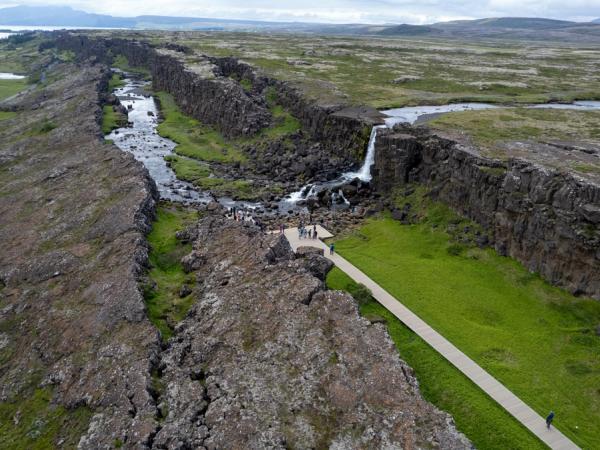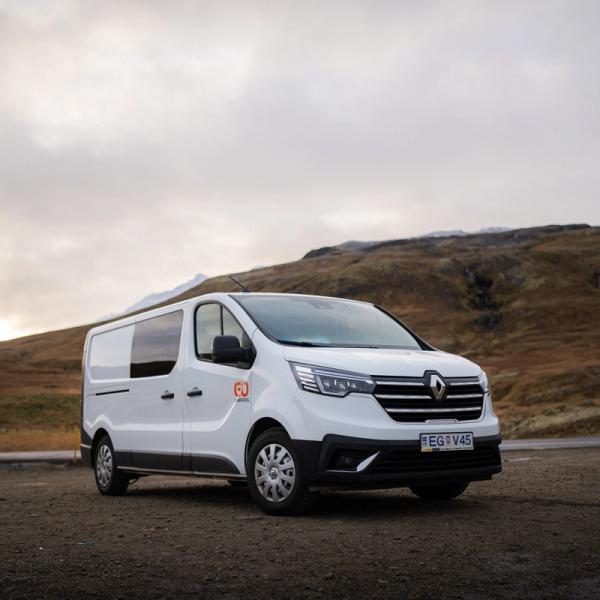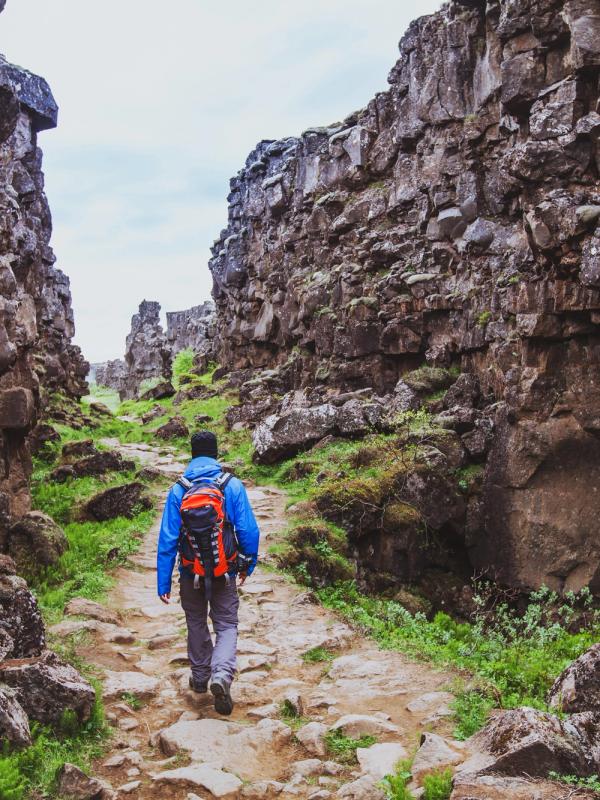
Almannagjá Gorge, the canyon that separates two continents
Iceland is a fascinating place in many senses. Here, we can see places that are both geologically fascinating and visually stunning.
Regarding this combination, not many places can compete with the Almannagjá Gorge, a place where the earth reveals its dynamic forces. And now, it offers a rare chance to walk between continents. Literally, it is not a figure of speech.
The gorge combines geological wonders with deep historical roots, as we’ll explain later, which add even more layers to its beauty. Additionally, the surrounding area is one of the most impressive in Iceland, and there are several camping options nearby. Let’s go!
Key Takeaways
- Almannagjá is a gorge that marks the separation between the North American and the Eurasian tectonic plates.
- This rift valley is located within Þingvellir National Park, one of Iceland's three national parks.
- The park is one of the three main stops in the Golden Circle, the most iconic scenic route in the country.
What's Almannagjá?
Almannagjá Gorge is a deep rift or canyon formed by the tectonic plates pulling apart. It is a unique geological feature that is difficult to see anywhere else in the world. It’s the border between the North American and the Eurasian tectonic plates, and it’s part of Þingvellir National Park, one of the three national parks in Iceland.
This impressive fissure stretches approximately 7.7 kilometers (4.8 miles) in length and reaches depths of up to 40 meters in certain areas. Its width varies depending on the area. In some parts, it’s a narrow passage barely a few meters wide, while it’s a broader valley in other points.
This amazing element started to form thousands of years ago by the slow separation of these two tectonic plates. In fact, this process hasn’t stopped, and the plates continue to move apart at a rate of roughly 2 centimeters per year. The gorge features dark basalt rock walls, covered in green moss and lichen in certain areas. Cracks and smaller fissures branch off from the main rift, and some are filled with water that filters through the porous lava, creating crystal-clear pools.
At a historical level, this part of Þingvellir National Park has been really important. Here, early Icelanders used to gather to discuss politics and make laws. In fact, the name "Almannagjá" translates to "Everyman's Gorge," reflecting its historical role as a gathering place accessible to all citizens.
When visiting Þingvellir National Park, Almannagjá is, without a doubt, one of the highlights. You can follow a well-maintained path that winds through the gorge, getting close views of the dramatic cliffs and the different parts of the gorge. In winter, everything is covered in snow, adding a different texture.
As part of Þingvellir, a UNESCO World Heritage Site, Almannagjá perfectly represents the unique geographical position of Iceland. Here, volcanic activity and plate tectonics have shaped, and still do, the land in real time.
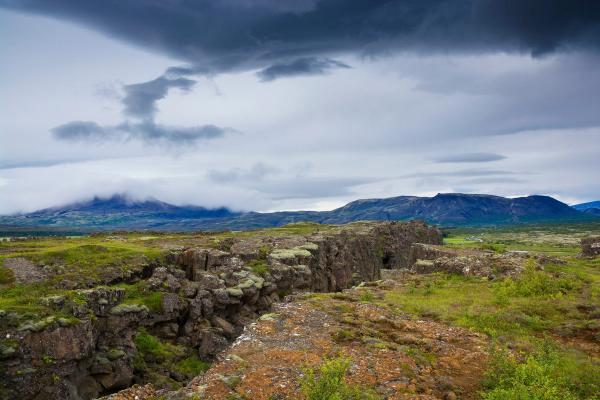
Þingvellir National Park
Visiting Almannagjá is an experience that goes beyond the gorge itself.
Beyond the gorge, Þingvellir has an immense historical value. Here is where the Alþingi, Iceland’s parliament and the world’s oldest existing one, was first established in the year 930 AD.
The Lögberg, or Law Rock, is just by the gorge, and it’s a big boulder from where the law speaker would recite the country’s laws.
The separation between the plates can also be seen underwater. The Silfra Fissure is one of the most thrilling experiences available in the park. Visitors can dive here, touching both plates at the same time, with visibility up to 100 meters.
The park is also full of life. At its center is Þingvallavatn, Iceland’s largest lake, which is home to fish like Arctic char and brown trout, as well as birds such as the harlequin duck and the great northern diver. Not far away is Öxarárfoss, a beautiful 20-meter waterfall that was redirected in the Middle Ages to supply water to the Alþingi.
With its trails, history, and incredible natural sights, you can feel the connection between nature and history, making Þingvellir one of the best visits in all of Iceland.
Where's the Almannagjá Gorge and How to Get There
Visiting the Almannagjá Gorge is quite easy. Þingvellir National Park is located in the southwest of the country, not too far from Reykjavik, and it’s well connected by road. The park lies 50 kilometers (31 miles) from the capital.
The best way to go is by car or campervan, giving you the flexibility to explore the area at your own pace and stop along the way. Also, with your own campervan, you can draw your preferred itinerary and sleep in one of the campsites in the area to fully discover everything.
If you’re coming from Reykjavík, head north on Route 1, the Ring Road, for roughly 15 kilometers (9 miles) until you reach the town of Mosfellsbær. Once you’ve crossed the city, turn right onto Route 36, which leads directly into Þingvellir National Park after about 30 kilometers (19 miles). The drive takes around 45 minutes in good conditions, and all the roads are paved and suitable for most vehicles year-round. However, in winter, the conditions can be harsher, and some secondary roads may be closed, or you’ll need chains or winter tires.
You’ll find several parking areas in the park. There’s one right by the visitors’ center, which is the main gateway to the park for most visitors. The daily fee is ISK 1,000 (around €7 or $8).
There are also bus tours that go to this area to see the main sights in a guided visit. However, in these, you usually have to follow a tight schedule, with little time to fully absorb the amazing things you’re seeing.
What to See and Do Near the Almannagjá Gorge
Visiting the Almannagjá Gorge and, by extension, Þingvellir National Park is one of the best travel experiences in Iceland. These sites are part of the Golden Circle, a route that connects some of the best a. It consists of three main stops (Þingvellir is one of them) and several secondary ones.
Geysir Geothermal Area
A bit further east from Almannagjá, we arrive at the next stop in the Golden Circle, the Geysir Geothermal Area in Haukadalur Valley. It’s a geothermal area with steaming vents and bubbling mud pots. But the star here is the Strokkur geyser, which erupts every 5-10 minutes, sending water up to 20 meters high (66 feet). The original Great Geysir, now mostly dormant, gave the word "geyser" to the world. There are several walking paths to cover the area, seeing colorful mineral deposits.
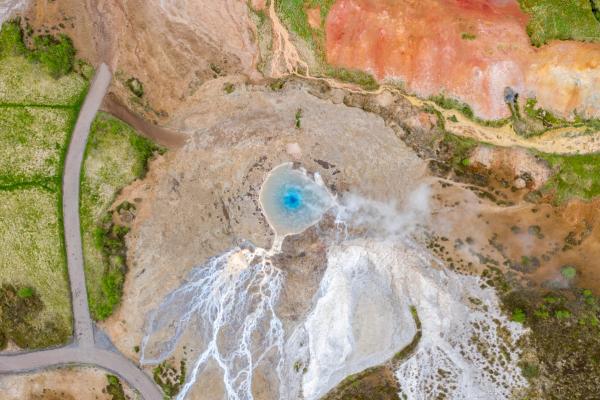
Gullfoss
If we continue a few kilometers further east, we’ll get to the third main stop of the Golden Circle: Gullfoss. Its name means “golden falls” in Icelandic due to the colorful effect the sun rays create on the mist. It’s a two-tier cascade with a total drop of 32 meters (105 feet) on the Hvitá River. It’s a remarkably powerful waterfall, especially in late spring or early summer, when the snowmelt increases the river's flow. There are two viewing platforms with different points of view. One takes you closer to the falls, while the other gives a more panoramic perspective.
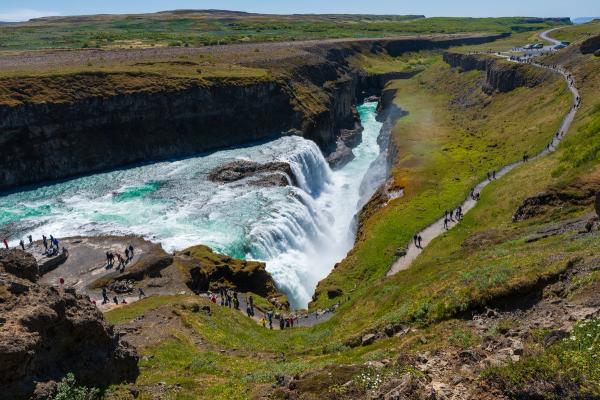
Laugarvatn Fontana
The Laugarvatn Fontana is a geothermal spa located on the shores of Lake Laugarvatn, about 25 kilometers (16 miles) southeast of Almannagjá. It features various outdoor pools with temperatures ranging from 36 to 40°C (96.8-104°F), where you can take a relaxing bath while enjoying stunning views. This place also offers visitors a unique treat: to watch rye bread being baked, buried in the sand, using geothermal energy. You can also try it with handmade butter afterwards.
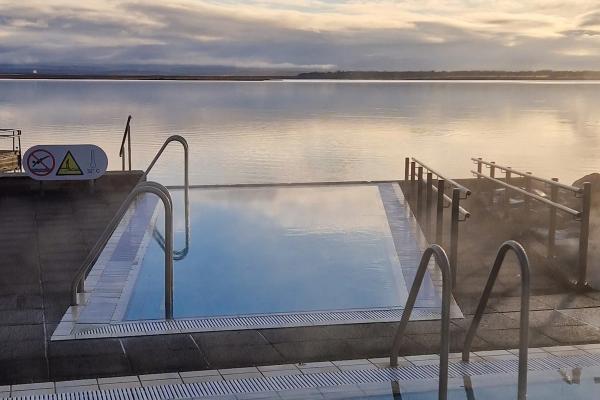
Kerið Crater
Kerið is an ancient volcanic crater, now also a lake, that shines due to its vibrant colors. The red and black rocks contrast beautifully with the blue water that fills the crater. It was formed around 3,000 years ago, meaning Kerið is relatively young in geological terms. There’s also a path around the crater rim that offers stunning panoramic views. Another trail leads down to the water’s edge for a closer view.
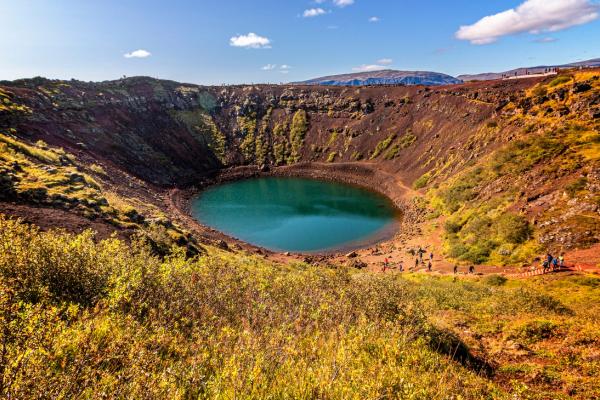
Bruarfoss
We now move to another waterfall on the route. Not as big and powerful as Gullfoss, but certainly full of beauty. Bruarfoss is not very well known and is somewhat hidden, so many tourists tend to skip it. It’s often called ·the blue waterfall” because of the intense turquoise color of its waters. Reaching it requires a moderate hike of approximately 3 kilometers (2 miles) each way from the parking area located by the road, but the path is part of the visit, as it includes walking through mossy fields and crossing streams over wooden bridges.
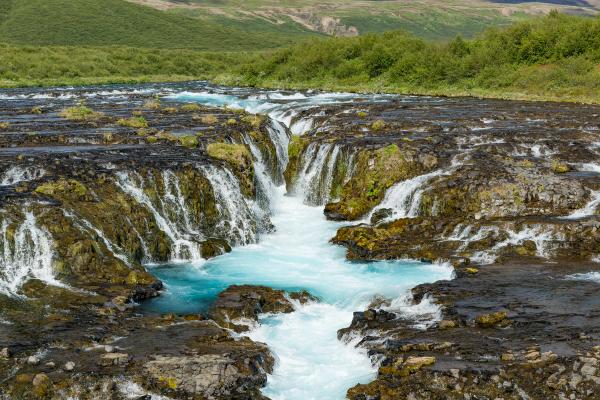
Secret Lagoon
The Secret Lagoon in Flúðir, approximately 60 kilometers (37 miles) southeast of Almannagjá, is Iceland's oldest natural pool, maintaining a temperature of 38-40°C (100.4-104°F) year-round. Surrounded by steaming vents and small geysers, it offers a more rustic bathing experience compared to other, more modern spas, such as the Laugarvatn Fontana, but it still features changing facilities and a café. One of the best things about the Secret Lagoon is that, unlike busier spas, it retains a more intimate feel, and many locals come here to unwind.
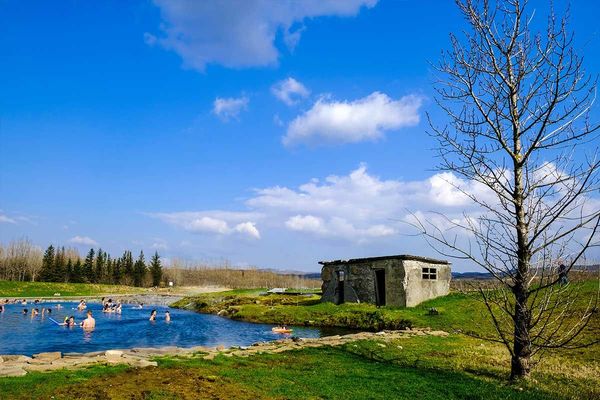
Where to Stay Near the Almannagjá Gorge
Traveling with a campervan around this region is great because you’ll reach anywhere you like whenever you want, and you have plenty of options for spending the night in one of the camping grounds that are nearby. Although the beautiful landscapes are inviting, it’s essential to note that wild camping is forbidden in Iceland, so please stick to designated areas.
Þingvellir Nyrðri Leirar
Distance to Almannagjá: 2 kilometers (1.2 miles).
Opening Period: All year.
This is the closest you can sleep to the Almannagjá Gorge. It’s just by the visitors’ center of Þingvellir National Park. The campsite features pitches for campervans, toilets, showers (which may not work in freezing temperatures), electricity (available only in summer), and outdoor cooking facilities. There is no advance booking for the campsite, but there is usually plenty of space available.
Laugarvatn Camping Ground
Distance to Almannagjá: 30 kilometers (18.6 miles).
Opening Period: June to September.
Located near Lake Laugarvatn and close to the Fontana, this site offers leveled pitches for vans, featuring amenities such as toilets, showers, electricity hookups, Wi-Fi, dishwashing sinks, washing machines, and outdoor sinks. As an added bonus, all guests staying at the campsite receive a 20% discount on food at Vinastræti Restaurant, located just across the road.
Úlfljótsvatn Campsite
Distance to Almannagjá: 30 kilometers (18.6 miles)
Opening Period: May 15 to September 15.
This site by Lake Úlfljótsvatn is one of the largest camping grounds in Iceland, with a capacity for 5,000 guests. It has toilets, showers, electricity, a BBQ area, playgrounds for kids, and a shop for basics. It’s a great site for outdoor activities that can be organized through the staff at the campsite. These include fishing, football, canoeing, and disc golf.
Geysir Camping Site
Distance to Almannagjá: 58 kilometers (36 miles)
Opening Period: May to September.
Right by the Geysir Geothermal Area, this camping ground is perfect for those wanting to stay close to the action. It’s spacious, with grassy pitches for campervans and tents. It offers toilets, showers, electricity, Wi-Fi, and a washing machine. There’s a restaurant across the road, and there’s even a golf course nearby. The setting makes it unique, but it can get quite busy during peak season.
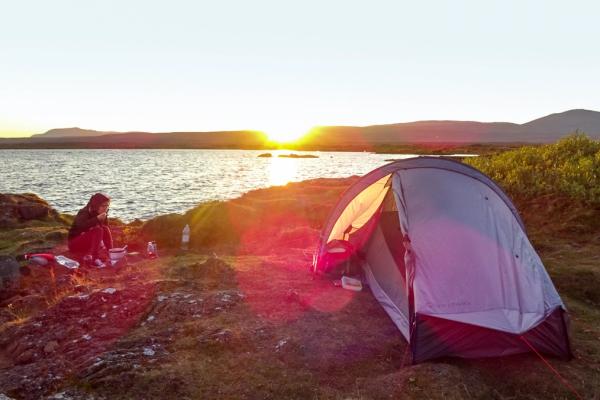
The seasons at the Almannagjá Gorge
The weather can have a huge impact on a road trip through Iceland, as the country’s road system depends on the conditions. Luckily, the region where the Almannagjá Gorge sits is not as cold as other parts of the country. Knowing what to expect in the different seasons can help you be more prepared.
- Summer (June to August) brings mild temperatures of 10-15°C (50-59°F) and up to 21 hours of daylight thanks to the Midnight Sun, ideal for exploring the gorge and the national park. It’s a mix of sunny spells with sudden rain. It’s peak season, so expect more tourists.
- In Autumn (September and October), the temperatures drop to 5-10°C (41-50°F), and the days become gradually shorter. The park's landscapes display beautiful fall colors, but rain and wind become more frequent. Some campsites start to close before winter, and hiking trails can be muddy and slippery. On the other hand, there are not many tourists.
- Winters (November to March) in Iceland are long and harsh, with temperatures typically below the freezing point, ranging from -5 °C to 0°C (23°F to 32°F). The snow covers all the area, adding layers and textures to the edges of the gorge. The days are very short, so it’s essential to plan the outdoor activities for the few hours of natural light. Although the roads leading to the national park are in good condition, heavy snow can close some roads, so always check the status. This is the season with the highest probability of seeing the Northern Lights.
- Spring (April and May) sees temperatures rise to 0-10°C (32-50°F). The melting snow makes rivers and waterfalls look stunning, and many migratory birds visit the wetlands surrounding Lake Þingvallavatn. There could still be some days of snow, so come prepared for all events.
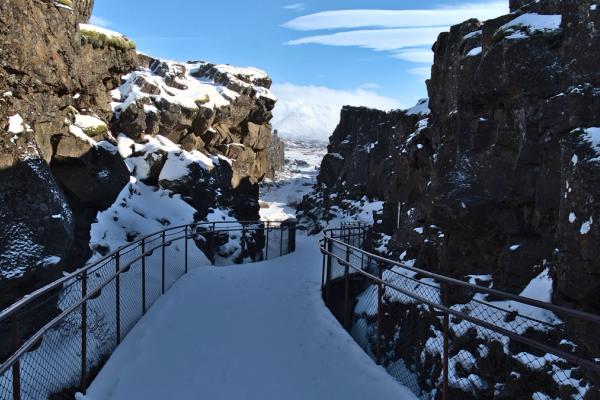
What to Pack to Visit the Almannagjá Gorge
- Waterproof jacket and pants for sudden rain.
- Sturdy hiking boots with good grip for the uneven, rocky paths.
- Dressing in layers is key to adapting to the weather shifts. Thermal base layer, fleece as intermediate, and a waterproof outer layer.
- Hat, gloves, and scarf. Even in summer, the nights can be chilly.
- Sunglasses and sunscreen.
- Reusable water bottle, as tap water is safe and fountains are available in different parts of the national park.
- First-aid kit with basics like bandages and insect repellent.
Travel Tips
- Check the road conditions before departure, particularly in winter when snow may affect secondary routes.
- Pay the 1,000 ISK parking fee online or at machines to avoid fines.
- Arrive early to avoid bus tour crowds and enjoy the area more to yourself, especially in summer.
- Stick to marked paths to protect the fragile ecosystem.
- Fuel up in Reykjavík, as gas stations are limited along the Golden Circle. Once in this area, go to bigger towns if you need to fill up.
Conclusion
Not many sights in Iceland are as impressive and with a richer history than the Almannagjá Gorge. It’s an amazing geological feature, visually striking. The surrounding Þingvellir National Park is one of the best visits tourists can make in the country, with awesome sights and a rich history and culture. On top of that, it is inside an area full of natural wonders, with plenty of options to sleep as part of a campervan journey.

